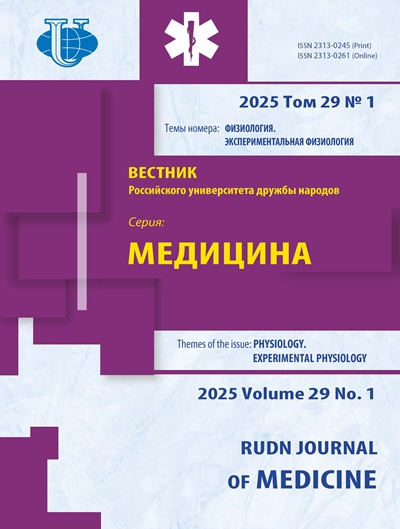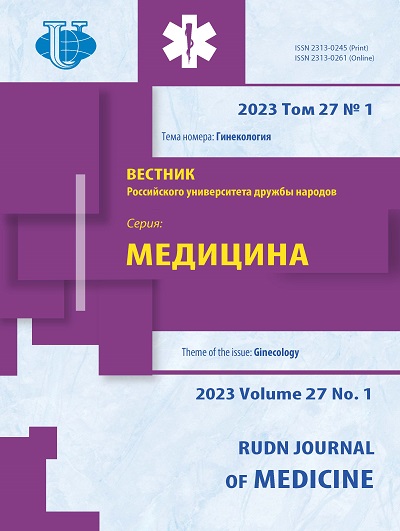Гиперплазия эндометрия и резистентность к прогестерону - непростые взаимоотношения
- Авторы: Оразов М.Р.1, Михалёва Л.М.2, Муллина И.А.1
-
Учреждения:
- Российский университет дружбы народов
- Научно-исследовательский институт морфологии человека имени академика А.П. Авцына Российского научного центра хирургии имени академика Б.В. Петровского
- Выпуск: Том 27, № 1 (2023): ГИНЕКОЛОГИЯ
- Страницы: 65-70
- Раздел: ГИНЕКОЛОГИЯ
- URL: https://journals.rudn.ru/medicine/article/view/34090
- DOI: https://doi.org/10.22363/2313-0245-2023-27-1-65-70
- EDN: https://elibrary.ru/TEFBIJ
Цитировать
Полный текст
Аннотация
Эндометрий является одним из самых динамичных тканей, который постоянно подвергается изменениям во время менструального цикла у женщин репродуктивного периода. Все эти процессы происходят в основном под влиянием стероидных гормонов, которые вырабатываются в организме женщины. Однако нужно помнить, что в течение жизни эндометриальная ткань под воздействием различных факторов претерпевает изменения, которые приводят к дисбалансу гормональных регуляций. Все изменения могут привести к развитию гиперплазии эндометрия, которая имеет высокий риск как рецидивирования, так и малигнизации. За последние несколько десятилетий заболеваемость раком эндометрия увеличилась во многих странах. Предполагается, что эта тенденция связана с ростом распространенности ожирения, а также с изменением женских репродуктивных моделей. Хотя в настоящее время нет хорошо зарекомендовавших себя программ скрининга рака эндометрия, гиперплазия эндометрия является признанным предшественником, и ее обнаружение дает возможность для профилактики. Изучение патогенеза и факторов риска даст большое преимущество в будущем предотвратить возможные осложнения. На данный момент активность и ингибирование действий различных изоформ гормонов могут привести к разным гиперпластическим процессам. Менеджмент пациенток зависит от многих факторов: возраст, вид, репродуктивный потенциал и другие факторы. Поэтому всегда необходим комплексный подход к лечению. В последние годы в связи с ростом рака эндометрия резко увеличился интерес к изучению вопросов о гиперплазии эндометрия, в связи с чем вопрос о ранней диагностике и профилактике наиболее остро стоит в современной гинекологии и требует дальнейшего изучения. В обзоре отражены современные представления нарушения механизмов передачи сигналов прогестерона при гиперплазии эндометрия по данным отечественной и зарубежной литературы.
Ключевые слова
Об авторах
М. Р. Оразов
Российский университет дружбы народов
Email: 211irina2111@rambler.ru
ORCID iD: 0000-0002-1767-5536
Москва, Российская Федерация
Л. М. Михалёва
Научно-исследовательский институт морфологии человека имени академика А.П. Авцына Российского научного центра хирургии имени академика Б.В. Петровского
Email: 211irina2111@rambler.ru
ORCID iD: 0000-0003-2052-914X
Москва, Российская Федерация
И. А. Муллина
Российский университет дружбы народов
Автор, ответственный за переписку.
Email: 211irina2111@rambler.ru
ORCID iD: 0000-0002-5773-6399
Москва, Российская Федерация
Список литературы
- MacLean JA 2nd, Hayashi K. Progesterone Actions and Resistance in Gynecological Disorders. Cells. 2022;11(4):647. doi: 10.3390/cells11040647
- Gellersen B, Brosens JJ. Cyclic decidualization of the human endometrium in reproductive health and failure. Endocr Rev. 2014;35(6):851-905. doi: 10.1210/er.2014-1045
- Burney RO, Talbi S, Hamilton AE, Vo KC, Nyegaard M, Nezhat CR, Lessey BA, Giudice LC. Gene expression analysis of endometrium reveals progesterone resistance and candidate susceptibility genes in women with endometriosis. Endocrinology. 2007;148(8):3814-26. doi: 10.1210/en.2006-1692
- Kao LC, Germeyer A, Tulac S, Lobo S, Yang JP, Taylor RN, Osteen K, Lessey BA, Giudice LC. Expression profiling of endometrium from women with endometriosis reveals candidate genes for disease-based implantation failure and infertility. Endocrinology. 2003;144(7):2870-81. doi: 10.1210/en.2003-0043
- Houshdaran S, Nezhat CR, Vo KC, Zelenko Z, Irwin JC, Giudice LC. Aberrant Endometrial DNA Methylome and Associated Gene Expression in Women with Endometriosis. Biol Reprod. 2016;95(5):93. doi: 10.1095/biolreprod.116.140434
- Houshdaran S, Oke AB, Fung JC, Vo KC, Nezhat C, Giudice LC. Steroid hormones regulate genome-wide epigenetic programming and gene transcription in human endometrial cells with marked aberrancies in endometriosis. PLoS Genet. 2020;16(6): e1008601. doi: 10.1371/journal.pgen.1008601
- Al- Sabbagh M, Lam EW, Brosens JJ. Mechanisms of endometrial progesterone resistance. Mol Cell Endocrinol. 2012;358(2):208-15. doi: 10.1016/j.mce.2011.10.035.
- McKinnon B, Mueller M, Montgomery G. Progesterone Resistance in Endometriosis: an Acquired Property? Trends Endocrinol Metab. 2018;29(8):535-548. doi: 10.1016/j.tem.2018.05.006
- Patel BG, Rudnicki M, Yu J, Shu Y, Taylor RN. Progesterone resistance in endometriosis: origins, consequences and interventions. Acta Obstet Gynecol Scand. 2017;96(6):623-632. doi: 10.1111/aogs.13156
- Li X, Feng Y, Lin JF, Billig H, Shao R. Endometrial progesterone resistance and PCOS. J Biomed Sci. 2014;21(1):2. doi: 10.1186/1423-0127-21-2
- DeMayo FJ, Zhao B, Takamoto N, Tsai SY. Mechanisms of action of estrogen and progesterone. Ann N Y Acad Sci. 2002;955:48-59; discussion 86-8, 396-406. doi: 10.1111/j.1749-6632.2002.tb02765.x
- Kim JJ, Kurita T, Bulun SE. Progesterone action in endometrial cancer, endometriosis, uterine fibroids, and breast cancer. Endocr Rev. 2013;34(1):130-62. doi: 10.1210/er.2012-1043
- Marquardt RM, Kim TH, Shin JH, Jeong JW. Progesterone and Estrogen Signaling in the Endometrium: What Goes Wrong in Endometriosis? Int J Mol Sci. 2019;20(15):3822. doi: 10.3390/ijms20153822
- Patel B, Elguero S, Thakore S, Dahoud W, Bedaiwy M, Mesiano S. Role of nuclear progesterone receptor isoforms in uterine pathophysiology. Hum Reprod Update. 2015;21(2):155-73. doi: 10.1093/humupd/dmu056
- Al- Sabbagh M, Lam EW, Brosens JJ. Mechanisms of endometrial progesterone resistance. Mol Cell Endocrinol. 2012;358(2):208-15. doi: 10.1016/j.mce.2011.10.035
- McKinnon B, Mueller M, Montgomery G. Progesterone Resistance in Endometriosis: an Acquired Property? Trends Endocrinol Metab. 2018;29(8):535-548. doi: 10.1016/j.tem.2018.05.006
- Patel BG, Rudnicki M, Yu J, Shu Y, Taylor RN. Progesterone resistance in endometriosis: origins, consequences and interventions. Acta Obstet Gynecol Scand. 2017;96(6):623-632. doi: 10.1111/aogs.13156
- Li X, Feng Y, Lin JF, Billig H, Shao R. Endometrial progesterone resistance and PCOS. J Biomed Sci. 2014;21(1):2. doi: 10.1186/1423-0127-21-2
- Moustafa S, Young SL. Diagnostic and therapeutic options in recurrent implantation failure. F1000Res. 2020;9: F1000 Faculty Rev-208. doi: 10.12688/f1000research.22403.1
- Savaris RF, Groll JM, Young SL, DeMayo FJ, Jeong JW, Hamilton AE, Giudice LC, Lessey BA. Progesterone resistance in PCOS endometrium: a microarray analysis in clomiphene citrate-treated and artificial menstrual cycles. J Clin Endocrinol Metab. 2011;96(6):1737-46. doi: 10.1210/jc.2010-2600
- Burney RO, Talbi S, Hamilton AE, Vo KC, Nyegaard M, Nezhat CR, Lessey BA, Giudice LC. Gene expression analysis of endometrium reveals progesterone resistance and candidate susceptibility genes in women with endometriosis. Endocrinology. 2007;148(8):3814-26. doi: 10.1210/en.2006-1692
- Guo SW. Epigenetics of endometriosis. Mol Hum Reprod. 2009;15(10):587-607. doi: 10.1093/molehr/gap064
- Attia GR, Zeitoun K, Edwards D, Johns A, Carr BR, Bulun SE. Progesterone receptor isoform A but not B is expressed in endometriosis. J Clin Endocrinol Metab. 2000;85(8):2897-902. doi: 10.1210/jcem.85.8.6739
- Оразов М.Р., Хамошина М.Б., Муллина И.А., Артеменко Ю.С. Гиперплазия эндометрия - от патогенеза к эффективной терапии // Акушерство и гинекология: Новости. Мнения. Обучения. 2021. Т. 9. № 3. С. 21-28.
- Kim JJ, Chapman- Davis E. Role of progesterone in endometrial cancer. Semin Reprod Med. 2010;28(1):81-90. doi: 10.1055/s-0029-1242998
- Singh G, Puckett Y. Endometrial Hyperplasia. In: StatPearls [Internet]. Treasure Island (FL): StatPearls Publishing. 2022. 461 p.
- Emons G, Beckmann MW, Schmidt D, Mallmann P; Uterus commission of the Gynecological Oncology Working Group (AGO). New WHO Classification of Endometrial Hyperplasias. Geburtshilfe Frauenheilkd. 2015;75(2):135-136. doi: 10.1055/s-0034-1396256
- Ørbo A, Arnes M, Vereide AB, Straume B. Relapse risk of endometrial hyperplasia after treatment with the levonorgestrel-impregnated intrauterine system or oral progestogens. BJOG. 2016;123(9):1512-9. doi: 10.1111/1471-0528.13763
- Erdem B, Aşıcıoğlu O, Seyhan NA, Peker N, Ülker V, Akbayır Ö. Can concurrent high-risk endometrial carcinoma occur with atypical endometrial hyperplasia? Int J Surg. 2018;53:350-353. doi: 10.1016/j.ijsu.2018.04.019
- Iversen ML, Dueholm M. Complex non atypical hyperplasia and the subsequent risk of carcinoma, atypia and hysterectomy during the following 9-14 years. Eur J Obstet Gynecol Reprod Biol. 2018;222:171-175. doi: 10.1016/j.ejogrb.2018.01.026
- Li L, Yue P, Song Q, Yen TT, Asaka S, Wang TL, Beavis AL, Fader AN, Jiao Y, Yuan G, Shih IM, Song Y. Genome-wide mutation analysis in precancerous lesions of endometrial carcinoma. J Pathol. 2021;253(1):119-128. doi: 10.1002/path.5566
- Pandey J, Yonder S. Premalignant Lesions Of The Endometrium. In: StatPearls [Internet]. Treasure Island (FL): StatPearls Publishing. 2022.
- Huvila J, Pors J, Thompson EF, Gilks CB. Endometrial carcinoma: molecular subtypes, precursors and the role of pathology in early diagnosis. J Pathol. 2021;253(4):355-365. doi: 10.1002/path.5608
- Carugno J, Marbin SJ, LaganÀ AS, Vitale SG, Alonso L, DI Spiezio Sardo A, Haimovich S. New development on hysteroscopy for endometrial cancer diagnosis: state of the art. Minerva Med. 2021;112(1):12-19. doi: 10.23736/S0026-4806.20.07123-2
- Yen TT, Wang TL, Fader AN, Shih IM, Gaillard S. Molecular Classification and Emerging Targeted Therapy in Endometrial Cancer. Int J Gynecol Pathol. 2020;39(1):26-35. doi: 10.1097/PGP.0000000000000585
- Cancer Genome Atlas Research Network, Kandoth C, Schultz N, Cherniack AD, Akbani R, Liu Y, Shen H, Robertson AG, Pashtan I, Shen R, Benz CC, Yau C, Laird PW, Ding L, Zhang W, Mills GB, Kucherlapati R, Mardis ER, Levine DA. Integrated genomic characterization of endometrial carcinoma. Nature. 2013;497(7447):67-73. doi: 10.1038/nature12113
- Ayhan A, Mao TL, Suryo Rahmanto Y, Zeppernick F, Ogawa H, Wu RC, Wang TL, Shih Ie M. Increased proliferation in atypical hyperplasia/endometrioid intraepithelial neoplasia of the endometrium with concurrent inactivation of ARID1A and PTEN tumour suppressors. J Pathol Clin Res. 2015;1(3):186-93. doi: 10.1002/cjp2.22
- Joshi A, Miller C Jr, Baker SJ, Ellenson LH. Activated mutant p110α causes endometrial carcinoma in the setting of biallelic Pten deletion. Am J Pathol. 2015;185(4):1104-13. doi: 10.1016/j.ajpath.2014.12.019
- Kim TH, Wang J, Lee KY, Franco HL, Broaddus RR, Lydon JP, Jeong JW, Demayo FJ. The Synergistic Effect of Conditional Pten Loss and Oncogenic K-ras Mutation on Endometrial Cancer Development Occurs via Decreased Progesterone Receptor Action. J Oncol. 2010;2010:139087. doi: 10.1155/2010/139087
- Suryo Rahmanto Y, Shen W, Shi X, Chen X, Yu Y, Yu ZC, Miyamoto T, Lee MH, Singh V, Asaka R, Shimberg G, Vitolo MI, Martin SS, Wirtz D, Drapkin R, Xuan J, Wang TL, Shih IM. Inactivation of Arid1a in the endometrium is associated with endometrioid tumorigenesis through transcriptional reprogramming. Nat Commun. 2020;11(1):2717. doi: 10.1038/s41467-020-16416-0
- Joshi A, Wang H, Jiang G, Douglas W, Chan JS, Korach KS, Ellenson LH. Endometrial tumorigenesis in Pten(+/-) mice is independent of coexistence of estrogen and estrogen receptor α. Am J Pathol. 2012;180(6):2536-47. doi: 10.1016/j.ajpath.2012.03.006

















